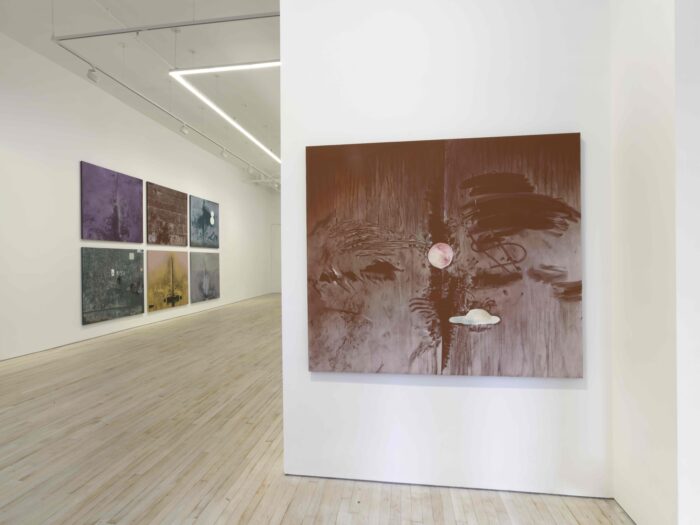
RAÚL ILLARRAMENDI: Alignment
Nino Mier Gallery, Tribeca
January 11 – February 24, 2024
Upon entering the gallery, you encounter a cityscape that mirrors the Tribeca streets you have just left behind. Despite being displayed on pristine white walls, the canvases capture the essence of urban exteriors—rolling shutters, concrete façades, and electrical boxes—each marked with authentic signs of age and wear. Raúl Illarramendi’s solo exhibition, Alignment, recently concluded at Nino Mier Gallery, blends urban history with his artistic practice, unveiling the intricate materiality found in both the cityscape and his paintings.
Central to the exhibition is Illarramendi’s Evidence of Absence (EA) series, which explores the often-overlooked facets of urban surfaces. Whether the prevailing color is green, red, or gray, the EA replicates the appearance of aged iron or concrete, embellished with a powdery, dust-like layer that lends a tangible sense of decay. Above this layer, bold streaks emerge; some evolve into abstract, swirling patterns, while others resemble familiar doodles or scribbles, such as dollar signs, the Paris Saint-Germain Football Club (PSG) acronym, emojis, and whimsical characters. These elements, whether erratic abstractions or specific symbols, reflect the spontaneous visual language found in urban environments, evoking the instinctual markings of early cave paintings.
During a 2020 interview with Anahita Vessier in Anahita’s Eye, Illarramendi shared, “[e]very trace represents an individual event, identity, intentionality, an accident that I construct, compose and control.” Illarramend focuses on urban surfaces that are often overlooked—perhaps, like the walls of a rarely used subway exit or a distribution box hidden in the corner of a shiny building. Despite their obscurity, these sites become canvases for the city’s inhabitants to spontaneously express their feelings and thoughts, serving as outlets for personal yearnings or frustrations, desires or dislikes, or simply as spaces for relieving boredom and demonstrating creativity. With a keen eye, Illarramendi captures these unrefined yet genuine expressions of human emotion on urban tableaux. In his EA series, every stroke and smudge is more than just a testament to the passage of time; it is also a narrative of human experience, inextricably linked to the city’s essence.

What stands out in Illarramendi’s approach is his unique method of reenacting such marks on his canvas: rather than removing material, he adds to it. Specifically, the traces, which appear to have been scraped off with a finger, are actually created by applying pencil, oil stick, and wax paste to the surrounding areas, leaving the sections untouched. This technique leads Illarramendi to describe his EA series not as painting but as drawing, or more accurately, as non-drawing, since the artwork emerges from the addition of material around the intended subject, rather than directly rendering the subject itself. The tools he opts for, dry pencil and oil stick, are chosen for their directness and factual nature, differing from more fluid, amendable paints. This method can be likened to an archaeological excavation, but with a twist: Illarramendi’s excavation reveals human activity through the addition of pigments on the canvas, rather than by subtracting them.
Thus, there is a deep irony in the series title, Evidence of Absence. The visible gestures on the canvas suggest, and quite literally represent, the “absence” of pigment, yet this very absence paradoxically highlights the “presence” of the artist—demonstrated through the extensive effort and meticulous labor that Illarramendi pours into creating these marks. Furthermore, while the urban scenes in the EA depict environments devoid of people, the doodles and scribbles that embellish these spaces bear witness to the persistent influence of human life and activity: they are an affirmation of human presence.

A city is more than just a geographical space; it is also a medium that molds our experiences, communications, and cultures. It is not solely the famous urban landmarks that unveil the city’s rich historical tapestry and the narratives of its inhabitants; the unconventional and overlooked areas equally disclose the subtle intricacies and complexities characterizing the urban environment and those who dwell within it. While Piet Mondrian’s sleek, grid-like paintings symbolize the ideal of urban balance, Illarramendi’s exuberant, spontaneous abstractions underscore the human aspect—the dynamic energy and vibrant diversity that are foundational to the city’s order and harmony.
In today’s rapidly evolving urban landscape, the city is transforming into a smart hub, interconnected by lighting-fast cables. Amidst this transformation, the images encountered on the streets—whether they are digital advertisements or traditional posters—are increasingly created and edited as intangible data through prompts entered into computer-based generative tools. In this setting, the tangible markers of human existence—the vivid testimony of daily life and activity—risks being overshadowed by a flood of stimulating, effortlessly generated images. It is against this backdrop that Illarramendi’s practice gains significance. Through the EA series, Illarramendi adeptly “aligns” the mediums of the city and painting, bridging the visible with the invisible, the tangible with the virtual, and the present with the absent. This alignment represents a conscientious effort to reclaim the obscured and overlooked human dimensions of urban existence, offering a contemplative counterbalance to the prevailing sense of detachment.
